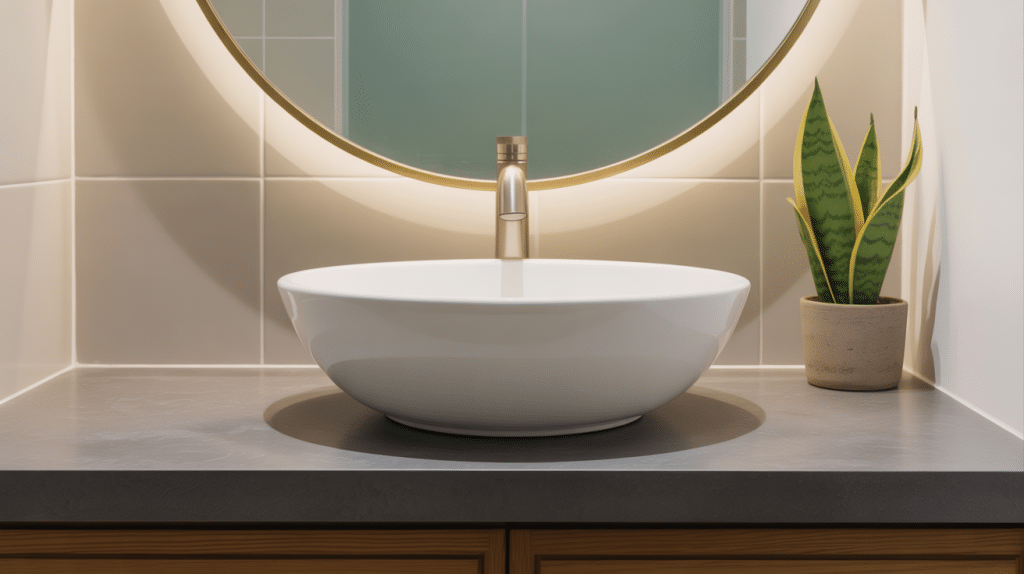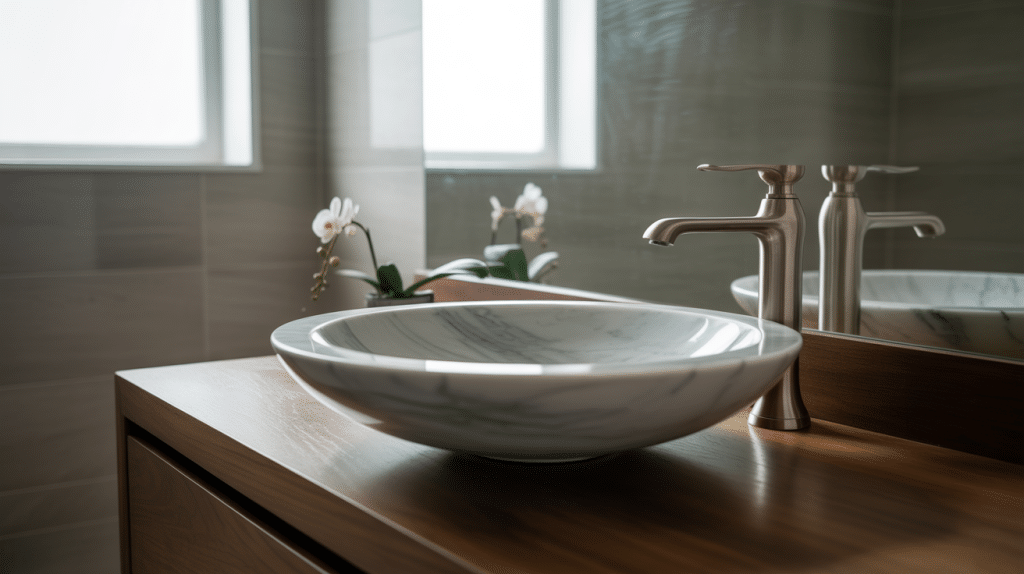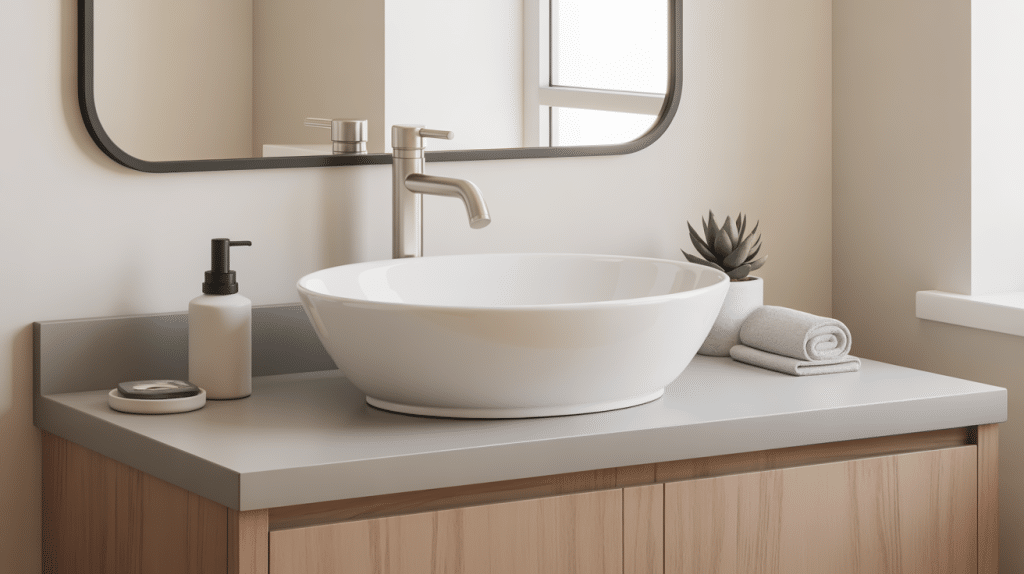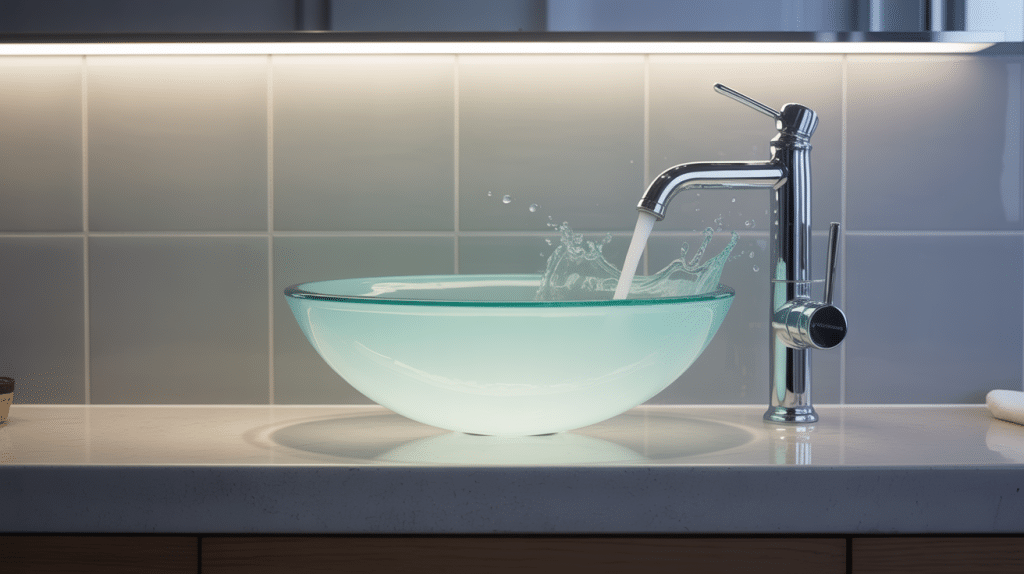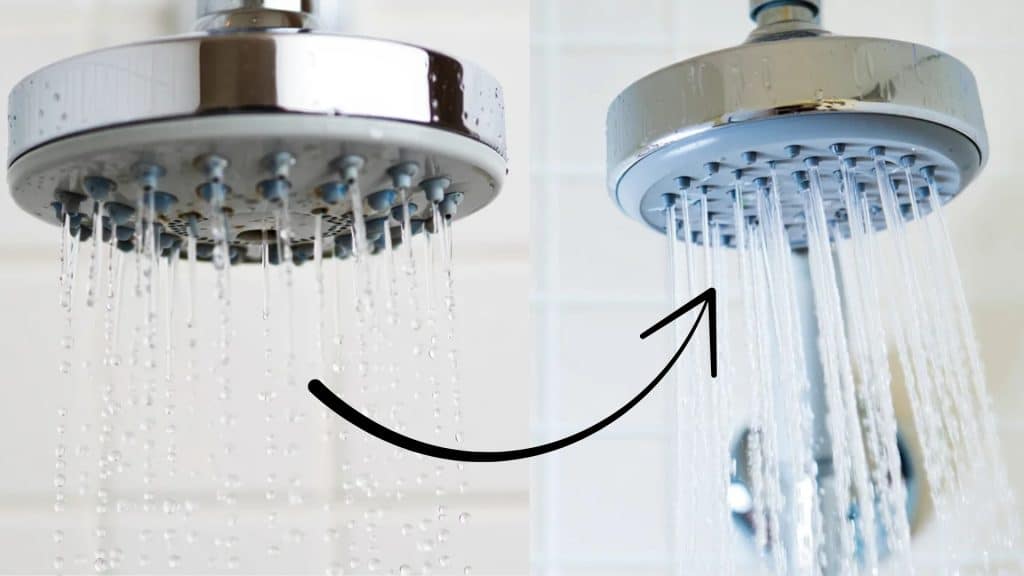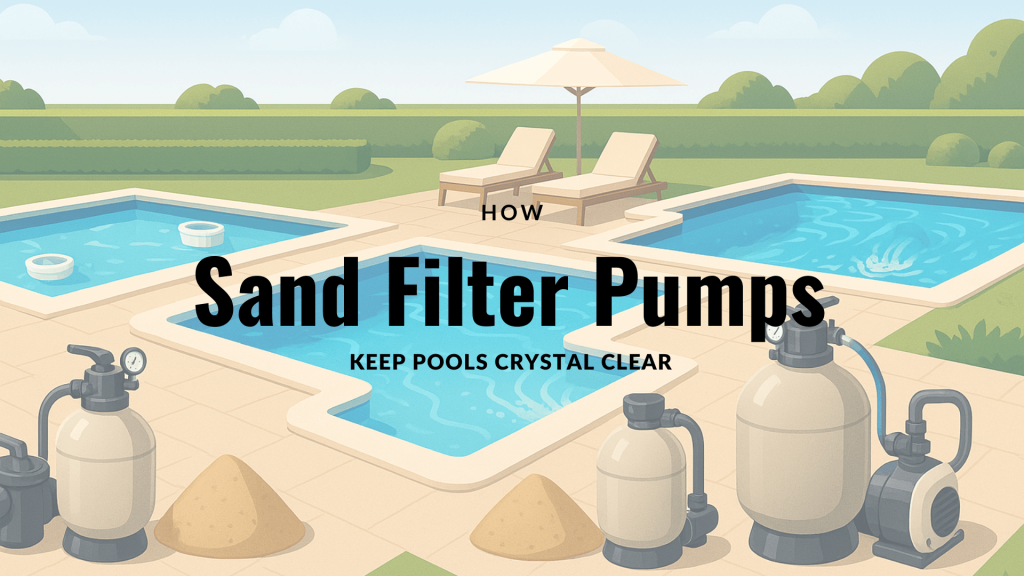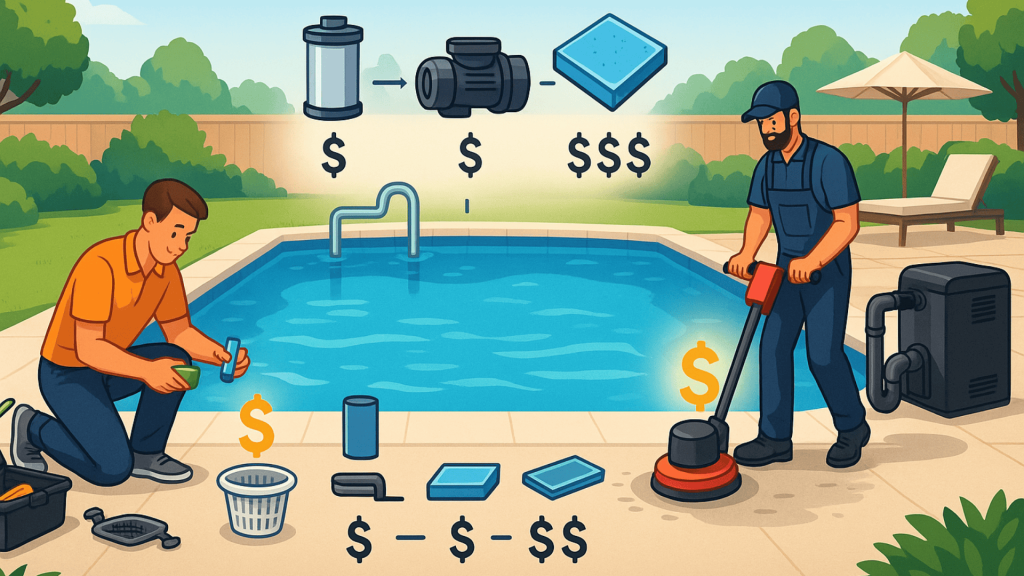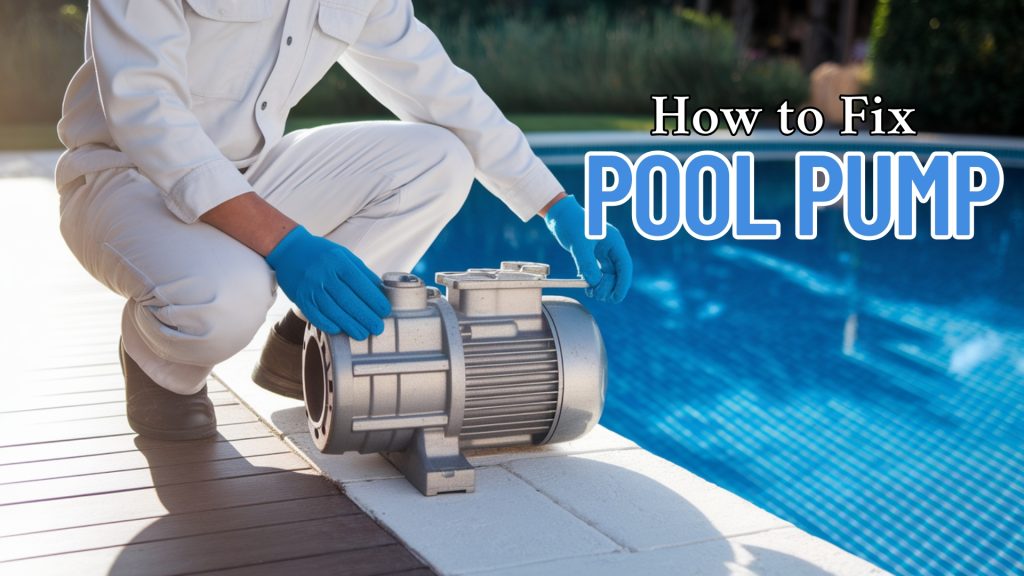Ever thought about how the right sink can completely enhance your bathroom’s design and functionality?
Choosing the perfect sink isn’t just about practicality’s about making a statement.
Vessel sinks, with their stylish design, offer a unique way to enhance your space while serving a functional purpose.
Unlike traditional sinks that are set into the countertop, vessel sinks sit on top, bringing a distinctive look and modern flair to any bathroom.
Installing a vessel sink can refresh your bathroom’s style and make everyday routines more enjoyable, if you’re updating your space or starting new.
Here’s how adding a vessel sink can improve both the design and functionality of your bathroom.
What is a Vessel Sink?
A vessel sink is a striking, freestanding basin that sits above the countertop, making it a statement piece in any bathroom.
Available in a wide variety of materials such as glass, ceramic, stone, copper, and concrete, each material offers unique aesthetic and functional qualities.
Vessel sinks also come in a range of shapes, including round, square, oval, and even custom designs, making them highly adaptable to any bathroom style.
From sleek, minimalist designs to options with rich texture and character, vessel sinks create a striking and functional focal point in any bathroom.
The Aesthetic Appeal of Vessel Sinks
Vessel sinks are known for their striking visual appeal. They are stylish and offer immense design flexibility.
Their wide range of materials, shapes, and sizes allows them to complement almost any bathroom style.
From modern minimalist bathrooms featuring clear glass bowls to more natural and rustic themes where stone or copper may be used, vessel sinks can bring any vision to life.
Creating a Focal Point
The position of the vessel sink is its most distinguishing feature, drawing immediate attention to the sink area.
This is especially beneficial for smaller bathrooms, where creating a bold visual statement can revamp the space.
The sink becomes a conversation starter, and when paired with the right faucet, it can add an extra touch of style.
Complementary Faucet Options
The faucet selection is just as important as the sink itself. Tall, single-handle faucets or wall-mounted options are ideal for vessel sinks.
These faucet styles enhance the visual impact and complement the height of the sink.
The pairing of a well-chosen faucet and vessel sink creates a cohesive, striking design that can truly define the space.
Functional Benefits of Vessel Sinks
While vessel sinks are undeniably beautiful, their functionality adds even more value to their appeal.
They’re not just for aesthetics—they are designed to enhance your daily experience.
Vessel sinks are a game-changer for smaller bathrooms.
Their unique design frees up valuable counter space, which is especially important in tighter quarters.
With more counter area available, you can store toiletries, display decor, or create a cleaner, more spacious environment.
This space-saving feature makes them the perfect option for those working with limited bathroom real estate.
Easy Maintenance
Another reason vessel sinks are becoming increasingly popular is their ease of maintenance.
Unlike undermount sinks, which can have hard-to-reach areas beneath the counter, vessel sinks have fewer hidden spots, making them easier to clean.
The exposed exterior is simple to wipe down, and cleaning products can be easily applied without worrying about tight, inaccessible spaces.
Ergonomic Design
The raised height of a vessel sink offers ergonomic benefits that traditional sinks can’t match.
With the basin positioned at a comfortable level, there’s less bending over to wash your face or brush your teeth.
This reduces strain on your back and makes the sink more comfortable to use for individuals of all heights.
For those with mobility concerns, this added comfort can make a big difference in day-to-day use.
Pros and Cons of Vessel Sinks
Vessel sinks come with a range of benefits that make them a popular choice for modern bathrooms.
However, like any design element, they also have some drawbacks to consider.
| PROS | CONS |
|---|---|
| Stylish and visually striking, serving as a focal point | Durability concerns, especially with fragile materials like glass and porcelain |
| Offers design flexibility with various shapes, materials, and sizes | Prone to splashing, requiring careful faucet selection |
| Space-saving, freeing up counter space in smaller bathrooms | Can be more expensive compared to traditional sinks |
| Easy to install with fewer modifications needed | Limited overflow options, increasing the risk of flooding |
| Ergonomic design reduces bending over, enhancing comfort | Requires regular maintenance, especially for materials like glass or copper |
Whether your priority is striking design or everyday practicality, vessel sinks provide a distinctive option for elevating your space.
Practical Considerations Before Installation
Before jumping into installing a vessel sink, it’s essential to consider a few practical aspects that could affect your overall experience.
Proper planning and attention to detail can help you avoid common installation mistakes and ensure your new sink looks and functions perfectly.
1. Splashing Issues
One of the most common issues with vessel sinks is splashing.
Due to the raised height, the water can splash more than it would with a traditional sink.
However, this can be easily minimized with the right faucet choice.
The best options are wall-mounted faucets or tall, single-handle faucets that direct water straight down into the sink.
By choosing the right faucet, you can enjoy the beauty of a vessel sink without the mess.
2. Cleaning and Maintenance
While vessel sinks are easier to clean than some other sink styles, they do require regular upkeep.
Materials like glass and copper, for example, may show water spots or require periodic treatments to maintain their appearance.
Be sure to choose a material that aligns with your cleaning preferences and lifestyle.
For example, glass sinks may need more frequent polishing, while stone or ceramic sinks can be wiped down easily without as much effort.
3. Countertop Height Adjustments
When installing a vessel sink, it’s essential to adjust the countertop height accordingly.
Traditional countertops are typically set at 32-34 inches, but with a vessel sink, the height may need to be slightly lower to ensure comfort.
Consider how the sink height will work with your existing vanity and make adjustments to ensure usability for everyone in the household.
This may involve lowering the countertop or choosing a custom vanity designed for vessel sinks.
The Bottom Line
Incorporating a vessel sink into your bathroom is more than just a design choice—it adds both visual appeal and everyday convenience.
These sinks introduce a modern, luxurious touch to any bathroom, while also offering benefits like saving counter space, easy cleaning, and comfortable use.
Choosing the perfect vessel sink involves considering factors like material, style, and installation needs to ensure it fits seamlessly into your bathroom.
Though they require some attention to faucet choice and height adjustments, the aesthetic and practical advantages they offer far outweigh the challenges.
Looking for a standout feature for your bathroom?
A vessel sink could be the perfect addition, combining beauty and practicality in one stylish piece.
Frequently Asked Questions (FAQs)
1. Are Vessel Sinks Suitable for Small Bathrooms?
Yes, vessel sinks are a great choice for smaller bathrooms.
Their design helps save counter space, allowing you to make the most of limited space while adding a bold visual statement.
2. Can I Install a Vessel Sink Myself?
The vessel sink is easier to install than a traditional undermount sink.
However, it’s often recommended to consult a professional for proper installation, especially for plumbing adjustments and faucet selection.
3. How Do I Prevent Splashing With a Vessel Sink?
It’s essential to choose the right faucet to minimize splashing.
Wall-mounted or tall, single-handle faucets work best, as they direct the water flow into the sink without creating excess splashing.
4. Do Vessel Sinks Have Overflow Drains?
Many vessel sinks do not come with built-in overflow drains.
To avoid potential overflow issues, it’s important to keep the sink clean and well-maintained.

